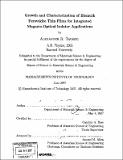| dc.contributor.advisor | Caroline A. Ross. | en_US |
| dc.contributor.author | Taussig, Alexander R | en_US |
| dc.contributor.other | Massachusetts Institute of Technology. Dept. of Materials Science and Engineering. | en_US |
| dc.date.accessioned | 2007-11-16T14:20:39Z | |
| dc.date.available | 2007-11-16T14:20:39Z | |
| dc.date.copyright | 2007 | en_US |
| dc.date.issued | 2007 | en_US |
| dc.identifier.uri | http://hdl.handle.net/1721.1/39543 | |
| dc.description | Thesis (S.M.)--Massachusetts Institute of Technology, Dept. of Materials Science and Engineering, 2007. | en_US |
| dc.description | Includes bibliographical references (leaves 145-156). | en_US |
| dc.description.abstract | In this thesis, we discuss the motivation for integrated magneto-optical isolators and explain why the orthoferrite is such an attractive materials class for this purpose. We then derive from first physical principles the dependence of Faraday rotation, absorption, and certain figures of merit on the material's dielectric tensor elements. Next, we use pulsed laser deposition to grow thin films of BiFeO3 on MgO (001) and SrTiO3 (001) substrates. After optimizing growth conditions to obtain high quality films, we characterize the films' crystal structure with two-dimensional x-ray diffraction. We then examine the magnetic, optical, and magneto-optical properties of these films. We find that the highly textured films grown on SrTiO3 are monoclinic with an out-of-plane c-axis aligned with the (001) direction of the substrate and approximate pseudocubic lattice parameters of a = b = 4.04 A, c = 3.95 A, and 90° - [beta] = -0.88°. These films are weakly magnetic, with a magnetization of 1.2 emu/cm3 at an applied field of 10 kOe; highly absorptive, with an average absorption coefficient of 910 cm-1; and possess a low specific Faraday rotation of 320/cm at 1.8 kOe of applied field. As expected, we find that the magneto-optical figure of merit is negligible for this material due to its high absorption, which we attribute to a thin surface layer of phase separated bismuth and iron oxides caused by bismuth segregation during growth. We offer additional explanations for these values and show the first results of newer, more promising work with mixed cation perovskite. | en_US |
| dc.description.statementofresponsibility | by Alexander R. Taussig. | en_US |
| dc.format.extent | 156 leaves | en_US |
| dc.language.iso | eng | en_US |
| dc.publisher | Massachusetts Institute of Technology | en_US |
| dc.rights | M.I.T. theses are protected by copyright. They may be viewed from this source for any purpose, but reproduction or distribution in any format is prohibited without written permission. See provided URL for inquiries about permission. | en_US |
| dc.rights.uri | http://dspace.mit.edu/handle/1721.1/7582 | |
| dc.subject | Materials Science and Engineering. | en_US |
| dc.title | Growth and characterization of bismuth perovskite thin films for integrated magneto-optical isolator applications | en_US |
| dc.type | Thesis | en_US |
| dc.description.degree | S.M. | en_US |
| dc.contributor.department | Massachusetts Institute of Technology. Department of Materials Science and Engineering | |
| dc.identifier.oclc | 174043034 | en_US |
